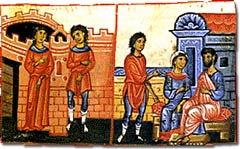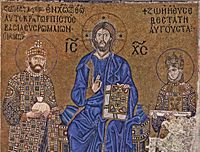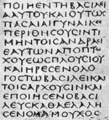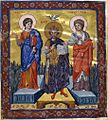Byzantine Greeks facts for kids

Medieval Greek marriage and family life.
|
|
| Regions with significant populations | |
|---|---|
| Byzantine Empire (esp. Asia Minor, Balkans) | |
| Languages | |
| Medieval Greek | |
| Religion | |
| Orthodox Christianity |
The Byzantine Greeks (or Byzantines) were the Greek people of Late Antiquity and the Middle Ages. They lived in the lands of the Byzantine Empire (or Eastern Roman Empire) like Greece, Asia Minor and Cyprus. They spoke medieval Greek, preserved Greek culture, obeyed Roman law and followed Eastern Christianity. Their society had peasants, traders, teachers, soldiers and priests.
Contents
Identity
The Byzantines called themselves Romans (Romaioi), Greeks (Graikoi) and Christians (Christianoi) throughout their history. They used those names synonymously because they were the political heirs of the Roman Empire, the offspring of the ancient Greeks, and believers in Jesus Christ. The Byzantines also called everything that was not Greek "barbarian".
Society

Byzantine Greek society had different classes like the poor, the peasants, the soldiers, the teachers, the merchants, and the priests.
Poor and peasants
There were two groups of poor people in the Greek world since the time of Homer: the ptochos (πτωχός, "passive poor") and the penes (πένης, "active poor"). Byzantine Greek peasants lived in villages, drank wine and ate grains, beans, fish, bread and olives. They were hunters, fishers, bee-keepers, craftsmen, smiths, tailors and shoemakers.
Soldiers and teachers
Soldiers were chosen for military duty every year and served as medics and technicians. Their appearance, customs, habits and life were part of a Greek and Roman military tradition. Along with farmers, they ate a type of dried biscuit bread called a paximadion (originally called a boukelaton).
Byzantine education was part of an ancient Greek educational tradition that started in the 5th century BC. It was made up of three levels: 1) elementary school with students aged six to ten years old, 2) secondary school with students aged ten to sixteen years old, 3) higher education.
Literacy was much higher in the Byzantine Empire than in Western Europe. Elementary school education was widely available in places like towns and the countryside. Secondary schools were mostly in larger cities and higher education was offered at the University of Constantinople.
In elementary schools, teachers used simple fairy-tale books like Aesop's Fables. In secondary schools, teachers used ancient Greek texts like the Iliad and the Odyssey of Homer.
Women
The life of a Byzantine Greek woman was split into three stages: 1) girlhood, 2) motherhood and 3) widowhood. Daily life for women included doing household and farm chores. Poor women sometimes wore sleeveless tunics and most wore a veil called the "maphorion" that covered their hair. Wealthy women bought and wore silk fabrics and clothes with expensive jewelry. Some women worked as traders, clerics and teachers.
Traders and priests
Byzantine Greek traders were mobile and developed new methods of investing money like the "chreokoinonia". Byzantine Greek priests were close to the rest of society and were allowed to get married (except for bishops).
Related pages
Images for kids
-
Joshua portrayed as a soldier wearing the lamellar klivanion cuirass and a straight spathion sword (Hosios Loukas).
-
A page of 5th or 6th century Iliad like the one a grammarian might possess.
-
Gold solidus of Justinian II 4.42 grams (0.156 oz), struck after 692.
-
King David in the imperial purple (Paris Psalter).
-
The Entry of the Crusaders into Constantinople, by Eugène Delacroix, 1840.
See also
 In Spanish: Griegos bizantinos para niños
In Spanish: Griegos bizantinos para niños











